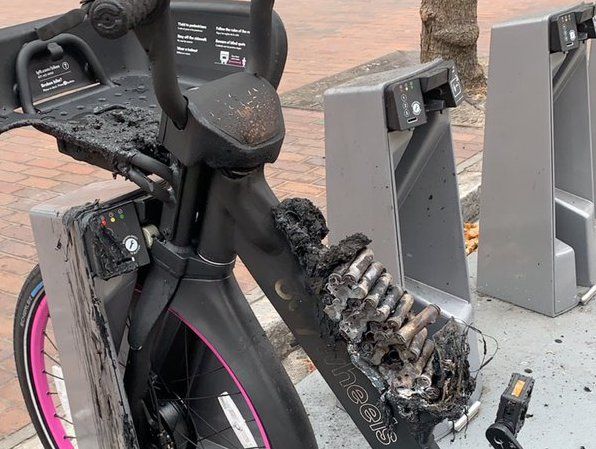Ebike batteries catching fire can be a significant safety concern for users. In recent years, there have been reported incidents of lithium-ion batteries, commonly used in Ebikes, catching fire due to various reasons such as manufacturing defects, improper charging, or overheating during use.
These incidents highlight the importance of choosing high-quality batteries from reputable manufacturers, adhering to proper charging protocols, and monitoring battery temperatures to mitigate the risk of fire. Ebike users must stay informed about battery safety guidelines and take necessary precautions to ensure a safe and enjoyable riding experience.

Credit: www.bicycling.com
Factors Contributing To Ebike Battery Fires
Battery Manufacturing Defects
One of the key factors that contribute to ebike battery fires is battery manufacturing defects. These defects can occur during the production process, leading to issues such as faulty wiring, insufficient insulation, or poor quality control. In some cases, manufacturers may use subpar materials that are not able to handle the demands of an ebike battery, increasing the risk of a fire.
Overcharging And Improper Charging Practices
Overcharging or improper charging practices can also result in ebike battery fires. When an ebike battery is overcharged, it can cause the cells inside to heat up excessively and become unstable. Additionally, using improper chargers or charging the battery at a higher voltage than recommended can also lead to dangerous levels of heat accumulation, potentially igniting a fire.
Physical Damage Or Misuse
Physical damage or misuse can significantly increase the likelihood of an electric bike battery catching fire. Accidentally dropping the battery or subjecting it to extreme temperatures can cause internal damage to the cells or compromise the battery’s structural integrity, making it more susceptible to thermal runaway. It is important to handle and store ebike batteries with care, following the manufacturer’s instructions to minimize the risk of fire.

Credit: www.bicycling.com
Notable Cases Of Ebike Battery Fires
As electric bicycles, commonly known as ebikes, continue to gain popularity as a greener alternative to traditional transportation, concerns about safety arise. One of the major safety issues associated with ebikes is the risk of battery fires. Over the years, there have been several notable cases that highlight the dangers of ebike battery fires. Understanding these incidents can help users make informed decisions and take necessary precautions to prevent accidents.
Case Study 1: Exploding Battery Incidents
Exploding battery incidents have been a cause for alarm in the ebike community. In one shocking case, which shook the industry, a rider experienced an unexpected explosion while charging the ebike’s battery. The explosion resulted in significant property damage and posed a serious threat to the rider’s safety. Investigations revealed that the explosion was caused by a faulty charging system, and the manufacturer was prompted to issue a product recall.
In another incident, an ebike battery explosion occurred while the rider was on a leisurely ride. The explosion caused not only injuries but also a fire outbreak, leading to substantial damage to the bike and nearby property. The investigation highlighted issues with battery quality and insufficient safety mechanisms implemented by the manufacturer.
These case studies emphasize the importance of thoroughly researching and selecting ebikes with reliable battery systems. It is crucial to choose batteries that have undergone extensive safety testing and meet international standards to reduce the risk of such incidents.
Case Study 2: Fire Outbreaks Caused By Ebike Batteries
Fire outbreaks caused by faulty ebike batteries have been a prevalent concern among riders. One case involved a rider who noticed smoke emanating from the battery compartment shortly after a ride. The small flame quickly grew into an intense fire, engulfing the bike and causing severe damage to surrounding property. Investigations traced the cause of the fire to a defective battery management system, which failed to detect and prevent excessive heat buildup.
Another fire outbreak occurred inside a rider’s home. The ebike battery, which was being charged overnight, suddenly caught fire, endangering the occupants and resulting in significant property damage. Upon investigation, it was determined that the fire was ignited by a defective battery cell, further emphasizing the critical importance of proper battery maintenance and the potential risks involved.
These case studies underscore the need for regular battery inspections, especially during charging, and the necessity to follow manufacturer guidelines for safe usage. Additionally, users must store their ebikes and batteries away from flammable materials and be vigilant for any signs of battery malfunction, such as unusual heat or smoke.
Preventive Measures And Safety Guidelines
Ebikes have become increasingly popular, but there have been concerns about battery safety. Learn about the preventive measures and safety guidelines to avoid ebike batteries catching fire. Stay informed and ride without worries.
Choosing Reputable Ebike Brands With Certified Batteries
When it comes to the safety of your ebike battery, one of the most crucial steps is selecting a reputable brand that uses certified batteries. Reputable brands understand the importance of quality and safety in their products, hence they invest in robust battery designs and follow stringent manufacturing standards.
Look for brands that have undergone extensive testing and certifications to ensure their batteries meet industry standards. Opting for certified batteries not only reduces the risk of fire-related incidents but also offers peace of mind that your ebike is equipped with a reliable power source.
Moreover, certified batteries often come with additional safety features such as temperature sensors, short-circuit protection, and overcharge protection, which further mitigate potential risks.
Proper Charging And Storage Practices
Proper charging and storage practices play a crucial role in maintaining the safety of your ebike battery. Here are some guidelines to ensure you charge and store your battery safely:
- Always use the charger provided by the manufacturer to prevent compatibility issues and potential hazards.
- Plug the charger directly into a dedicated wall socket and avoid using extension cords or power strips.
- Charge the battery in a well-ventilated area, away from flammable materials and heat sources.
- Do not leave the battery unattended while charging. While it may be tempting to charge overnight, it is best to monitor the charging process to promptly address any potential issues.
- Avoid overcharging your battery. Once it reaches a full charge, promptly disconnect it from the charger to prevent overheat and potential fire hazards.
- When storing your ebike battery, ensure it is stored in a cool and dry place, preferably at room temperature.
- Avoid exposing the battery to extreme temperatures, both hot and cold, as it can impact its performance and safety.
- Regularly check the charger and battery for any signs of damage or wear. If you notice any issues, refrain from using them and contact the manufacturer for further guidance.
Routine Battery Maintenance And Inspection
Regular maintenance and inspection of your ebike battery are essential to identify any potential issues before they escalate into more significant problems. Follow these guidelines to ensure your battery remains in optimal condition:
- Inspect the battery regularly for any physical damage, such as cracks or dents. If you notice any damage, discontinue use and consult a professional.
- Clean the battery terminals and connections periodically to ensure proper conductivity. Use a soft, dry cloth and avoid using water or cleaning agents.
- Monitor the battery capacity and performance. If you notice a significant decrease in the battery’s range or power output, it may be time for a replacement.
- Keep track of the battery’s age and usage. Most ebike batteries have a lifespan of 2-3 years, and excessive usage can reduce their overall performance and safety.
- Consider storing the battery with around 50% to 80% charge when not in use for an extended period. This helps prevent over-discharge or overcharge during storage.
- Refer to the manufacturer’s guidelines for specific maintenance instructions and recommended battery care.

Credit: www.curbed.com
Government Regulations On Ebike Battery Safety
Ensuring the safety of electric bicycles (ebikes) has become a top priority for governing authorities around the world. Particular attention is being paid to the batteries that power these bikes, as incidents of battery fires have raised concerns within the industry and among riders. In response, governments have implemented regulations to enhance the safety standards of ebike batteries and prevent potential hazards. This article explores the current regulations and standards, the efforts being made to improve battery safety, and the future outlook for enhancing the safety of ebike batteries.
Current Regulations And Standards
Government bodies have put forth stringent regulations and standards to mitigate the risks associated with ebike batteries. These regulations primarily focus on battery performance, manufacturing processes, and transportation guidelines. The aim is to ensure the batteries are built to withstand the rigors of everyday use and do not pose a threat to riders, bystanders, or surrounding environments. Here are some key aspects covered by current regulations and standards:
- Chemical composition: Batteries must meet specific chemical composition requirements to minimize the probability of combustion or explosion.
- Capacity limits: Regulations often impose limitations on the maximum capacity of ebike batteries to prevent overheating and reduce the risk of fire.
- Quality control: Manufacturers are required to adhere to strict quality control measures during the battery production process, including comprehensive testing to identify any potential defects.
- Transportation guidelines: Regulations outline proper packaging and transportation procedures to safeguard against damage, which can potentially lead to battery fires.
Efforts To Enhance Battery Safety
Recognizing the need for continued improvement, industry stakeholders and governing authorities are actively collaborating to enhance battery safety standards. Technology advancements and research initiatives are making significant strides in minimizing the risks associated with ebike batteries. Efforts to enhance battery safety include:
- Improved battery management systems: Manufacturers are incorporating state-of-the-art battery management systems that monitor performance, temperature, and safety parameters, ensuring early detection of any potential issues.
- Enhanced thermal management: Innovative thermal management techniques, such as advanced cooling systems and heat dissipation materials, are being implemented to effectively manage the heat generated during battery operation.
- Education and awareness campaigns: Governments and industry organizations are actively engaged in creating awareness among ebike users about the safe handling, charging, and storage of batteries to prevent accidents.
Future Outlook And Potential Improvements
The future of ebike battery safety looks promising, with ongoing research and development aimed at further improving battery performance and minimizing risks. Potential improvements include:
- New battery technologies: Researchers are exploring alternative battery chemistries that offer improved safety profiles, such as solid-state batteries with enhanced thermal stability and reduced fire risks.
- Regulatory updates: Governments continue to monitor industry developments and may revise existing regulations to reflect advancements in battery technology and address emerging safety concerns.
- Collaborative efforts: Manufacturers, regulatory bodies, and research institutions are working together to share knowledge and best practices, ensuring continuous advancements in battery safety.
By implementing and refining these regulations, standards, and innovative solutions, governments are making significant strides in enhancing the safety of ebike batteries. The collective efforts of industry stakeholders and governing authorities provide reassurance to riders, ensuring the potential risks associated with ebike batteries are minimized, and riders can enjoy their journeys with peace of mind.
Frequently Asked Questions On Which Ebike Batteries Are Catching Fire
What Ebike Batteries Catch Fire?
Ebike batteries that catch fire are typically caused by overheating, manufacturing defects, or improper use and maintenance. It’s important to choose a reliable battery from a reputable brand and follow proper charging and storage guidelines to reduce the risk of fire.
Regular maintenance and monitoring of the battery’s condition can also help prevent safety issues.
Which Batteries Are Most Likely To Catch Fire?
Lithium-ion batteries are the most likely to catch fire due to their chemical composition.
Have Bosch Ebike Batteries Caught Fire?
Yes, there have been cases of Bosch ebike batteries catching fire.
Which Lithium Batteries Are Prone To Fire?
Lithium-ion batteries are prone to fire due to their chemical composition. Their high energy density makes them more susceptible to overheating and thermal runaway, leading to fires. It is crucial to handle and store these batteries properly to minimize the risk of fire.
Why Are Some Ebike Batteries Catching Fire?
Some ebike batteries catch fire due to manufacturing defects, improper usage, or poor quality control measures.
Conclusion
To wrap up, it’s crucial to stay informed about the potential risks associated with e-bike batteries catching fire. While incidents are relatively rare, understanding the factors that contribute to such unfortunate occurrences can help users make informed choices. Regular maintenance, proper charging procedures, and using high-quality batteries from reputable manufacturers can greatly reduce the likelihood of these incidents.
Remember, the key is to prioritize safety and be proactive in ensuring the longevity and reliability of your e-bike batteries. Stay safe and enjoy your rides!




